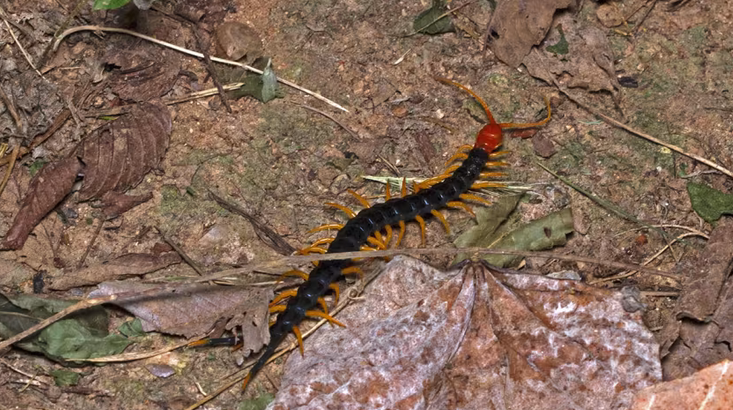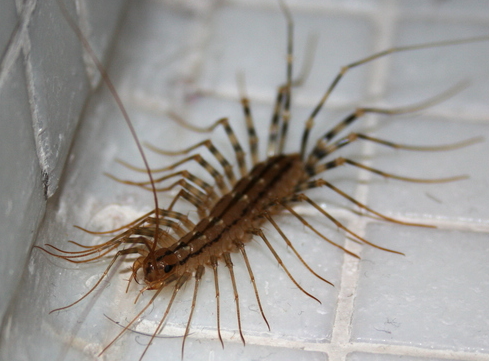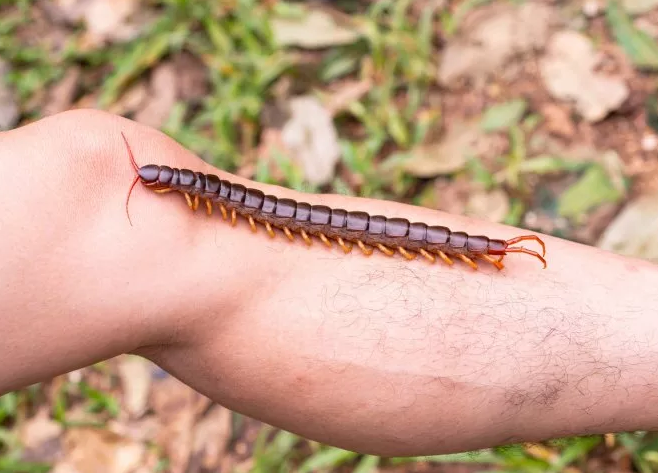It’s 3am when you’re roused from sleep. You stumble in the darkness toward your bathroom, turning on only a dim nightlight to illuminate your way. As you take a step into the room a flicker of movement catches your eye. You stare into the shadowy corners of the walls and wait, breath coming to you only in shallow bursts. After a moment of stillness, you let out a heavy sigh and continue forward. Trying to shake off the feeling that something is moving in the darkness around you, you take a few more deep breaths and finally give in to the urge to switch on the bathroom light. As soon as the room is bathed in brightness you see the movement once again, scurrying with blinding speed across the wall. Remembering it’s the middle of the night, you manage to resist a scream, but the long skittering legs of the creature make your every hair stand on end. You freeze, caught between the terror of approaching the nightmarish being and the absolute desire to not let it inhabit your home another moment. But in your hesitation the creature has an opportunity, and it slips into a crack by the sink and disappears deep into the recesses of your home, looking for the next dark room it can inhabit.
A cold shiver runs along your skin as you imagine it crawling out from the baseboard next to your bed, or creeping along the shower tiles till it’s eye-to-eye with you. Your stomach constricts. You head back to your bedroom, eyes darting to every shadow as you walk, anxiously waiting for the creature to rear its hideous head. You try to go back to sleep but every time you begin to close your eyes you think you see it crawling just at the edge of your vision. Grabbing your phone, you furiously search for the creature you just encountered, hoping it wasn’t actually as horrifying as it seemed. Maybe it was just a trick of the light. When you find it, and pictures of centipedes fill your screen, your skin prickles and a shaky breath catches in your throat: they are every bit as creepy as you feared. The only solace you can find is in calling The Bug Dude @ 1-800-310-BUGS (2847) and knowing that with their help you will soon be free from the grip of terror that this crawling menace has just placed you in.

What do Centipedes Look Like?
There are two main types of centipedes in Texas: the house centipede and the Texas giant redheaded centipede. Though you could potentially find either one scurrying across your walls (or even in your bed), the one you are most likely to encounter is the house centipede. The house centipede has a flattened, worm-like body that is approximately 1.5 inches long with a pair of long antennae and 15 pairs of long, slender legs; they can range in color from a dirty yellow to a dark brown. With their long legs, this species is known for its ability to run exceptionally quickly.
The Texas giant redheaded centipede, on the other hand, is more notable for its size than its speed, though it is still a very fast runner. This Texas-sized pest can grow up to 8 inches long! It has a flattened worm-like body with a pair of antennae and 21 pairs of legs (these legs are thicker and shorter than those of the house centipede). Its coloration is distinct and a clear warning sign (aposematic coloration) to not touch this venomous pest: it has a red head, black body, and yellow legs.

Where do Centipedes Live?
Whether indoors or outside, centipedes prefer to live in moist, protected areas. Outdoors you’re likely to find them under stones, leaves, rotting logs, or in loose tree bark. Indoors they will generally stay in damp areas such as bathrooms, closets, crawl spaces, or even in potted plants. They are nocturnal, so will spend the daylight hours in a protected location and venture out at night in order to hunt for food.
What do Centipedes Eat?
Centipedes are predators and will feed on a wide variety of other insects and even some small mammals. House centipedes will often feed on cockroach nymphs, spiders, silverfish, crickets, bedbugs, flies, moths, and earwigs. Texas giant redheaded centipedes will feed on even larger prey with common meals consisting of a wide variety of insects, mice, small snakes, small amphibians, and small mammals. Both types will kill their prey by grasping it with their powerful claws (located just behind the head) and injecting venom.

Are Centipedes Dangerous?
When it comes to discussing the relative dangers of centipedes, there’s good news and there’s bad news. The good news is that the most dangerous species of centipedes do not live in the United States. The other good news, is that neither of the common Texas centipedes are as dangerous as the black widow spider. The bad news is that centipedes are capable of delivering a nasty bite to humans and injecting us with their venom; this bite has been likened to a bee or wasp sting, with effects lasting several hours. Even worse, the Texas giant redheaded centipede has sharp claws at the tip of each of its many walking legs and it produces a poison at the attachment point of each leg, so as it walks across human skin it will not only cut into it, it will drip its poison into the wounds. This means that encountering a centipede could quickly become a painful endeavor whether they bite you or not.
Fortunately, their bite is not enough to do serious damage to the majority of healthy adults or to healthy dogs or cats. However, with venomous pests, there is always a chance of a dangerous allergic reaction, so any bites should be closely monitored. Additionally, those who are at high risk (young children, elderly, and those with health conditions) should be closely monitored if they are bitten by a centipede and medical attention should be sought if symptoms become severe or persistent.
It is also worth noting that if you have particularly small pets in the home (frogs, mice, etc.) they are at high risk of fatality if bitten by a centipede.

How do you Prevent Centipedes?
The most important first step to preventing centipedes from invading your home is to maintain a regular pest control service plan with The Bug Dude. By doing this not only will you eliminate any centipedes that may have sneaked into your house, but you will also keep your home from becoming an all-you-can-eat buffet for these predatory pests by reducing or eliminating their insect food sources.
In addition to maintaining a regular pest control service, here are a few tips to help make your home less inviting to these creepy-crawlies (remember, the first rule of thumb here is to reduce as much moisture in and around your home as possible):
- Keep compost piles, stones, and firewood piles away from your house
- Create a gravel barrier between your home’s foundation and any landscaping
- Regularly turn the mulch in any mulched landscaping to let it dry out
- Seal any cracks and crevices that could allow pests entry into your home
- Keep door and window seals in good condition
- Seal any gaps around plumbing penetrations
- Keep crawl spaces properly ventilated
- Keep your yard free from leaf litter and other debris
- Keep sprinkler systems in proper working order
- Make sure gutters are clear and downspouts direct water several feet away from the foundation
- Fix any plumbing leaks immediately
- If areas of your home are particularly damp, consider utilizing dehumidifiers
And remember, when looking for potential entry points, these creepy critters can easily climb up walls.
How do you Eliminate Centipedes?
When it comes to eliminating a centipede invasion, you need to be on the watch not only for these creepy-crawlies, but for any other pests that may be invading your home. Given the diet of a centipede, any pest infestation in your home would appear to them to be a fantastic buffet and a great invitation to make your house their home. And, since centipedes are nocturnal, you can go a long time without seeing one unless you happen to be a night owl, so you could wind up with a house full of these grotesque critters before you even know it. So at the first sighting of centipedes or an abundance of any other pest, call The Bug Dude at 817-354-5350 and let our expert technicians help you reclaim your peace of mind with a pest-free home.
As Halloween approaches, keep yourself free from unexpected scares, and call The Bug Dude at the first sign of a pest problem. And remember, centipedes are not just a bunch of hocus pocus!
Further Reading:
“Centipede” – Mike Merchant, Texas A&M Extension Entomology
“Centipede, Millipede” – Field Guide to Common Texas Insects, Texas A&M AgriLife Extension
“Centipedes/Millipedes” – Wizzie Brown, Extension Agent-IPM, The Texas A&M University System, Texas A&M Extension Entomology
“Giant redheaded centipede (July 25, 2013)” – Sydney Glass, Integrated Pest Management Intern – Texas A&M AgriLife Extension
“House Centipedes” – Steve Jacobs, Sr. Extension Associate, PennState Extension
“Giant Red-Headed Centipede” – Missouri Department of Conservation
Author Bio: Alissa Breach has been gaining knowledge and experience around pest control concerns over the last 13 years while working for Mid-Cities Pest Control. She has a creative writing BA from UW-Madison and is always pursuing new and interesting writing projects.




